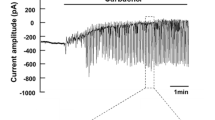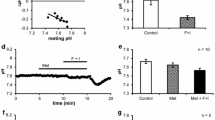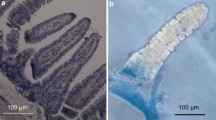Abstract
Acini isolated from the rat submandibular gland showed uptake of36Cl in the absence of added test substances. A steady state of36Cl content corresponding to 9.5±0.7 nM/mg protein was attained in 4–5 min and maintained for 25–30 min. This uptake of36Cl was reduced 40–50% by previous exposure to 10−3 M furosemide, 10−3 M ouabain, or K+-free medium. The steady state of36Cl content was reduced 34% by 10−6 M acetylcholine while exposure of the acini to the stilbene sulfonic DIDS (10−3 M) did not modify36Cl uptake either in the absence (basal) or presence of acetylcholine. Acetylcholine caused a rapid reduction of36Cl from tracer-preloaded acini (42% in 1 min), while furosemide induced a slower reduction of tracer content (45% in 9 min). Acetylcholine increased the rate of reduction of tracer content induced by furosemide and the latter caused a further reduction in36Cl content of acini previously exposed to acetylcholine. It is concluded that a furosemide-sensitive Cl uptake is present in rat submandibular acini, which depends on the Na+ gradient generated by the Na, K pump and on external K+. These findings suggest that a Na−K−Cl cotransport system driven by the Na, K pump is present in salivary acinar cells. Acetylcholine induces a rapid net efflux of36Cl, which probably masks any effect that this secretagogue may have on Cl uptake. The lack of effect of DIDS on36Cl uptake suggests that anion exchange transport systems are either not present in rat submandibular acini or can only be ascertained under different incubation conditions.
Similar content being viewed by others
References
Cabantchik ZI, Knauf PA, Rothstein A (1978) The anion transport system of the red blood cell. The role of membrane protein evaluated by the use of probes. Biochim Biophys Acta 515:239–302
Case RM, Hunter M, Novak I, Young JA (1984) The anionic basis of fluid secretion by the rabbit mandibular salivary gland. J Physiol (Lond) 349:619–630
Chipperfield AR (1980) An effect of chloride on (Na+K) cotransport in human red blood cells. Nature 286:281–282
Frizzell RA, Field M, Schultz SG (1979) Sodium-coupled chloride transport by epithelial tissues. Am J Physiol 236:F1-F8
Laugesen LP, Nielsen JOD, Poulsen JH (1976) Partial dissociation between salivary secretion and active potassium transport in the perfused cat submandibular gland. Pflügers Arch 364:167–173
Lowry OH, Rosebrough NF, Farr AL, Randall RJ (1951) Protein measurement with the Folin phenol reagent. J Biol Chem 193:265–278
Martinez JR, Quissell DO (1976) Potassium release from the rat submaxillary gland in vitro. II. Induction by parasympathomimetic secretagogues. J Pharmacol Exp Ther 199:518–526
Martinez JR, Cassity N (1983a) Effect of transport inhibitors on secretion by perfused rat submandibular gland. Am J Physiol 245:G711-G716
Martinez JR, Cassity N (1983b) Salivary secretion induced from isolated, perfused rat submandibular glands by sympathomimetic agents. Arch Oral Biol 28:1101–1108
Martinez JR, Cassity N (1984a) Effects of ouabain and furosemide on saliva secretion induced by sympathomimetic agents in isolated, perfused rat submandibular glands. Experimentia 40:557–559
Martinez JR, Cassity N (1984b) Cl− requirement for saliva secretion in the isolated, perfused rat submandibular gland. Am J Physiol (submitted)
Martinez JR, Bylund DB, Cassity N (1982) Progressive secretory dysfunction in the rat submandibular gland after excretory duct ligation. Arch Oral Biol 27:443–450
Maruyama Y, Gallacher DV, Petersen OH (1983) Voltage and Ca2+ activated K+ channel in basolateral acinar cell membranes of mammalian salivary glands. Nature 302:827–829
Musch MW, Orellana SA, Kimberg LS, Field M, Halm DR, Krasny EJ Jr, Frizzell RA (1982) Na+−K+−Cl− cotransport in the intestine of a marine teliost. Nature 300:351–353
Petersen OH (1970) Some factors influencing stimulation-induced release of potassium from the cat submandibular gland to fluid perfused through the gland. J Physiol (Lond) 208:431–447
Petersen OH (1971) Formation of saliva and potassium transport in the perfused cat submandibular gland. J Physiol (Lond) 216:129–142
Petersen OH, Poulsen JH (1980) Secretory potentials, potassium transport and secretion in the cat submandibular gland during perfusion with sulphate Locke's solution. Experientia 24:919–920
Petersen OH, Maruyama Y (1984) Calcium-activated potassium channels and their role in secretion. Nature 307:693–696
Poulsen JH, Kristensen LO (1982) Is stimulation-induced uptake of sodium in rat parotid acinar cells mediated by a sodium/chloride co-transport system? In: Case RM, Garner A, Thurnberg LA, Young JA (eds) Electrolyte and water transport across gastro-intestinal epithelia. Raven Press, New York, pp 199–206
Poulsen JH, Laugesen LP, Nielsen JOD (1982) Evidence supporting that basolaterally located Na+, K+ ATPase and a cotransport system for sodium and chloride are key elements in secretion of primary saliva. In: Case RM, Garner A, Thurnberg LA, Young JA (eds) Electrolyte and water transport across gastrointestinal epithelia. Raven Press, New York, pp 157–160
Quissell DO (1980) Secretory response of dispersed rat submandibular cells. I. Potassium release. Am J Physiol 238:C90-C98
Ramjeesingh M, Gaarn A, Rothstein A (1980) The location of a disulfonic stilbene binding site in band 3, the anion transport protein of the red blood cell membrane. Biochim Biophys Acta 599:127–139
Silva P, Stoff J, Field M, Fine L, Forrest JN, Epstein FH (1977) Mechanism of active chloride secretion by shark rectal gland: role of Na+, K+, ATPase in chloride transport. Am J Physiol 233:F298-F306
Widdicombe JH, Welsh MJ (1980) Ion transport by dog tracheal epithelium. Fed Proc 39:3062–3066
Young JA, van Lennep EW (1979) Transport in salivary and salt glands. In: Gibisch G (ed) Membrane transport in biology, vol 4. Springer, Berlin Heidelberg New York, pp 563–574
Author information
Authors and Affiliations
Rights and permissions
About this article
Cite this article
Martinez, J.R., Cassity, N. 36Cl fluxes in dispersed rat submandibular acini: Effects of acetylcholine and transport inhibitors. Pflugers Arch. 403, 50–54 (1985). https://doi.org/10.1007/BF00583281
Received:
Accepted:
Issue Date:
DOI: https://doi.org/10.1007/BF00583281




